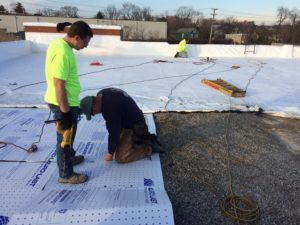Flat Roof Repair, made easier!
Maintaining a healthy flat roof is crucial for commercial buildings. A damaged or poorly maintained roof can lead to leaks, structural damage, and even health hazards for occupants. As a property owner or manager, you need to be aware of the different phases involved in commercial flat roof repair to ensure that your roof remains functional and safe.

Importance of Maintaining a Healthy Flat Roof
Before we dive into the process of commercial flat roof repair, it’s essential to understand why maintaining a healthy flat roof is crucial. A commercial flat roof protects the building’s interior and occupants from harsh weather conditions and external elements such as debris, animals, and insects. Regular maintenance and repairs prevent serious damage to the roof structure, which can lead to costly repairs and even replacement.
Phases of Commercial Flat Roof Repair
The process of commercial flat roof repair involves several phases:
Inspection Phase
An experienced contractor will inspect the roof to determine the extent of the damage. This phase may involve using various tools such as moisture meters and thermal imaging cameras to detect underlying damage not visible to the naked eye.
Evaluation Phase
The evaluation phase involves estimating the repair/replacement cost based on the inspection results and considering other factors such as the size of the roof, material used, safety requirements, and other unique factors.
Planning Phase
During the planning phase, the contractor creates a detailed plan for the repair work, including materials, equipment needed, and a timeline for the project. They will also consider safety measures during the repair work and develop a communication plan to keep tenants or employees informed during the repair process.
Repair/Replacement Phase
Depending on the extent of the damage, the repair work may involve patching, sealing, or replacing portions of the roof. Common materials used for commercial flat roofs include TPO, PVC, EPDM, and modified bitumen. Each material has its pros and cons, and the choice will depend on your specific needs and budget.
Choosing a Flat Roof Contractor
Choosing the right flat roof contractor is vital to ensure quality work and timely completion of the project. Look for a contractor with experience in commercial flat roof repair and a good reputation in the industry. Consider factors such as insurance coverage, licenses, and certifications to ensure that the contractor meets all legal requirements.
Safety Measures and Common Mistakes to Avoid
Safety should always be a top priority during commercial flat roof repairs. Ensure that the contractor follows all necessary safety measures to prevent accidents and injuries. Common mistakes to avoid include choosing low-priced contractors who may cut corners, not considering the long-term costs of repair, and neglecting regular maintenance.
In conclusion, commercial flat roof repair is a complex process that requires careful planning, efficient execution, and attention to detail. By understanding each phase of the process and following the tips provided, property owners and managers can ensure that their flat commercial roof remains functional and safe.